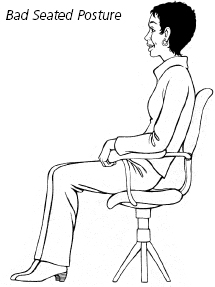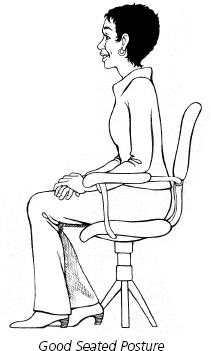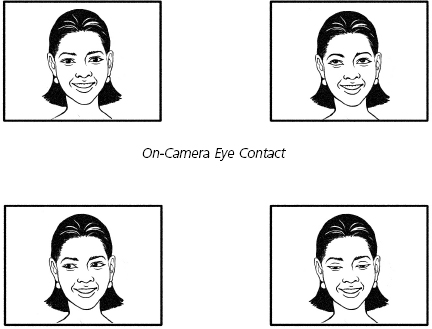The Well-Spoken Woman (24 page)
Read The Well-Spoken Woman Online
Authors: Christine K. Jahnke

Use one hand or two, but keep the hand or hands inside the box. Hands bobbing in and out of the box are moving in and out of camera range. The typical camera shot shows the area from the top of your head to the top of your chest. Hands moving beyond the tight frame look like little birds flitting about and are distracting. Pointing with one finger makes you look like a scold. Resist the temptation to reach the hand out to the camera like football players waving to mom on
Monday Night Football.
The hand will be distorted and appear overly large. Hold the hand or hands about six inches or so from the chest. Initially, this positioning may feel tight since the placement is different from how we gesture during regular conversation. Practice several times, and you will get a feel for the movement.
Quiet Hands
There are two good options for the hands when you are not gesturing: place one hand on each leg about midway down the leg with the fingers
closed or place one hand on top of the other on one leg. Both are “quiethand” positions, meaning they are not distracting to the viewer. Avoid gripping the armrests because you will look as if you are strapped to an electric chair. Don't rest your elbows on the armrests, either, because doing so will cause your posture to slump.
Shape Up: Animated Voice
Use your normal speaking voice. There is no need to dramatically raise the volume level because the microphone will pick it up. But if your voice sounds flat as a sidewalk, your message is easier to disregard. Get a sense of what sounds good by listening to the well-modulated voices of favorite radio announcers or news anchors, perhaps someone like CNN's Candy Crowley. Hear the cadence and the intonation. Notice the inflection and pacing. The five best ways to add interest to the voice are discussed in detail in
chapter 3
. Good vocal technique is as important on camera as it is in person. Use pace, pitch, pause, pronunciation, and projection to create a sense of interest, urgency, even drama, if the subject matter calls for it.
Shape Up: Posture
How you sit will go a long way toward determining whether or not you gain those extra TV pounds. The correct posture is essential to appearing slimmer and coming across as engaged with the viewer. When you are seated, it is crucial that you sit up straight and tilt forward slightly. Don't relax back in the chair or crouch, hunch, or slouch in the shoulders, as shown in the bad seated posture figure. If you sit back in the chair, you will appear frumpy and wider.
Sit up and tilt forward from the waist about two or three inches to position your head closer to the camera. This helps you look more engaged and will put you in a more conversational mode of talking, as shown in the good seated posture figure. As you lean forward, drop your shoulders back slightly.
You can position your legs and feet three different ways to enable you to lean in comfortably. The position you choose depends on how tall you
are, what you are wearing, and the type of chair. If you are tall and wearing pants, use the runner's position, which is just like it sounds. Place one foot slightly in front of the other on the ground as if you were about to take off in a 100-yard dash. This position allows you to balance your body weight forward on your feet as shown in the good seated posture. If you are wearing a dress or a skirt, it is more “ladylike” to cross your legs at the knee. Don't forget to sit up and lean forward, though, as there is a tendency to slouch with the legs crossed.

If you are shorter and/or wearing a shorter dress or skirt, cross your ankles and pull both feet straight back under the chair as shown in the fron-tview posture. This position will reduce the leg shot: less thigh, more skirt. It is also a more comfortable position if the chair or sofa lacks support. Sit forward, closer to the edge of the furniture, so your body weight is supported by the frame. This will prevent you from sinking into the cushions.

Standing Posture
For standing interviews or press conferences, avoid positioning the feet shoulder-width apart because this
stance facilitates swaying back and forth. Try a slight adjustment, using the champion stance detailed in
chapter 4
; place one foot slightly in front of the other. This stance will look and feel better. With one foot ahead, you will naturally move forward toward the camera and appear more interactive.

Shape Up: Eye Contact
As it is for public speaking, eye contact is the most important nonverbal technique for the camera. Where you focus your eyes depends on the type of appearance. For media interviews with a news reporter or program host, look directly at the reporter and maintain steady eye contact. Focus on one spot on the reporter and don't glance away while speaking. The instant you break eye contact, the movement seems exaggerated and you appear less credible. If the camera catches you looking up, you appear as if you are searching the heavens for the answer. Looking side to side will appear shifty. If you repeatedly look down, you come across as uncertain. Good, steady eye contact on one spot enables you to establish and maintain your credibility with the people watching at home. Look the reporter in the eye or at an earring or a necktie knot. It doesn't matter where you direct your gaze as long as it is in the general direction of the reporter's face.
Satellite and Webcasts
The spot where you direct your eye contact changes if you are doing a satellite interview or a virtual presentation. In those formats, you are often alone with the camera; there is no live audience. In a satellite newscast there is no one to look at because you hear the questions through an earpiece called an IFB. The earpiece allows you to hear what is happening on
air or in the director's control booth. Look directly into the center of the camera lens. The principle of steady eye contact remains unchanged; the only thing that is different is that you are looking into the camera lensânot up, not down, not all around.

When clients review their practice tapes, they are sometimes concerned when they see themselves blink. Blinking can be a problem if it is excessive. Neuropsychologists contend that stress can be measured by how often a person blinks. The normal blink rate for someone speaking on TV is 31 to 50 blinks per minute. People who are nervous can blink as rapidly as over 125 times per minute. If this is a worry, bear in mind that not blinking appears odd. You may come across as a wide-eyed zombie or space alien.
Shape Up: Upper-Body Movement
Upper-body movement helps you appear relaxed and confident, even if you don't feel that way. Many people hold themselves still because they
don't know what to do and are worried about making a mistake. Nervous anxiety can also cause people to freeze up. But holding yourself still will look stiff and ill at ease. In daily conversation, most people interact with each other by using nods, shoulder shrugs, and gestures. Experiment with some upper-body movement while you are talking. Avoid swaying from side to side or bobbing your head from shoulder to shoulder. It is more conversational to nod the head forward from time to time. Keep the shoulders relaxed and down so you can shrug for emphasis. Moving forward and back from the waist will help you look engaged in the dialogue.
Shape Up: Purposeful Practice
“I'll just wing it.” Nothing causes communications staff more heart palpitations than the spokesperson who doesn't appreciate the value of practice. On the airwaves, a bad performance can result in a major setback. Some clients go to great lengths to avoid on-camera practiceâcanceling or showing up lateâbut there is absolutely no substitute for practice. It is the most effective way to zero in on what works and what doesn't. The camera provides the feedback you need to improve. Be objective when viewing practice tapes, especially if you tend to fall victim to negative self-talk. Don't fall into the trap of obsessing about weight gain, and let Nora Ephron worry about the skin under her neck. No one is expecting a camera-ready performance the first time out.
The process isn't rocket science or brain surgery. In fact, I once had a neurologist ask me: “Do they really pay you to do this?” But it does take a commitment to a practice schedule. Practice can be done by hiring a media trainer or working with knowledgeable staff. Prepare for news interviews and talk-show appearances by having someone test your message and delivery techniques through mock interview exercises. Practice fielding a range of questions on a topic using the message map discussed in
chapter 5
and the SHAPE UP techniques discussed here. Initially, staying on message and projecting well will take some concentration. With practice, however, you will be able to internalize the techniques, and eventually more of your personality will come through. The techniques are the means to the end. As Orman says, the end is “to be who you are and forget about the camera.”
Try, Review, Refine
Some people, when watching their initial round of practice, feel that the SHAPE UP techniques make then appear robotic. Consider that what may feel unfamiliar and awkward to you does not appear that way to the viewing audience. You may be experiencing cognitive dissonance because what you think you are doing is not what you are actually doing. Upperbody animation, facial expression, and vocal inflection help you come across as engaged. In time you will develop muscle memory for the new postures and movements.
Retain new skills by scheduling brief refresher sessions every several months so that you're camera ready when a last-minute call comes in from CNN. Be sure to schedule additional time prior to major interviews and appearances so you can take full advantage of those opportunities. Reinforce the techniques by watching and analyzing the pros. Experienced broadcasters use the SHAPE UP techniques to deliver the news with confidence and poise. Note the vocal inflection and engaging body language of
Today Show
hosts Kathie Lee Gifford and Hoda Kotb. They are eminently watchable personalities with high likeability quotients. Tune into Orman and the women of
The View
to see how they maintain camera rapport while engaged in conversation.
A TV STAR IS MADE
Orman is an unlikely on-camera success story, which is part of what makes her so eminently watchable. As a child, she was an underperformer who suffered from low self-esteem. A speech impediment caused her to slur consonant sounds, and she still worries that if you listen closely, you can hear traces of slurred
s
's,
t
's, and
r
's. In grade school on the South Side of Chicago, Orman's speech impediment made reading aloud an excruciating experience. In college, she majored in social work after being told that with her grades, she wasn't going to amount to much. In 1973, she decided to move to California and spent the next six years waiting tables at a cafe in Berkeley.
